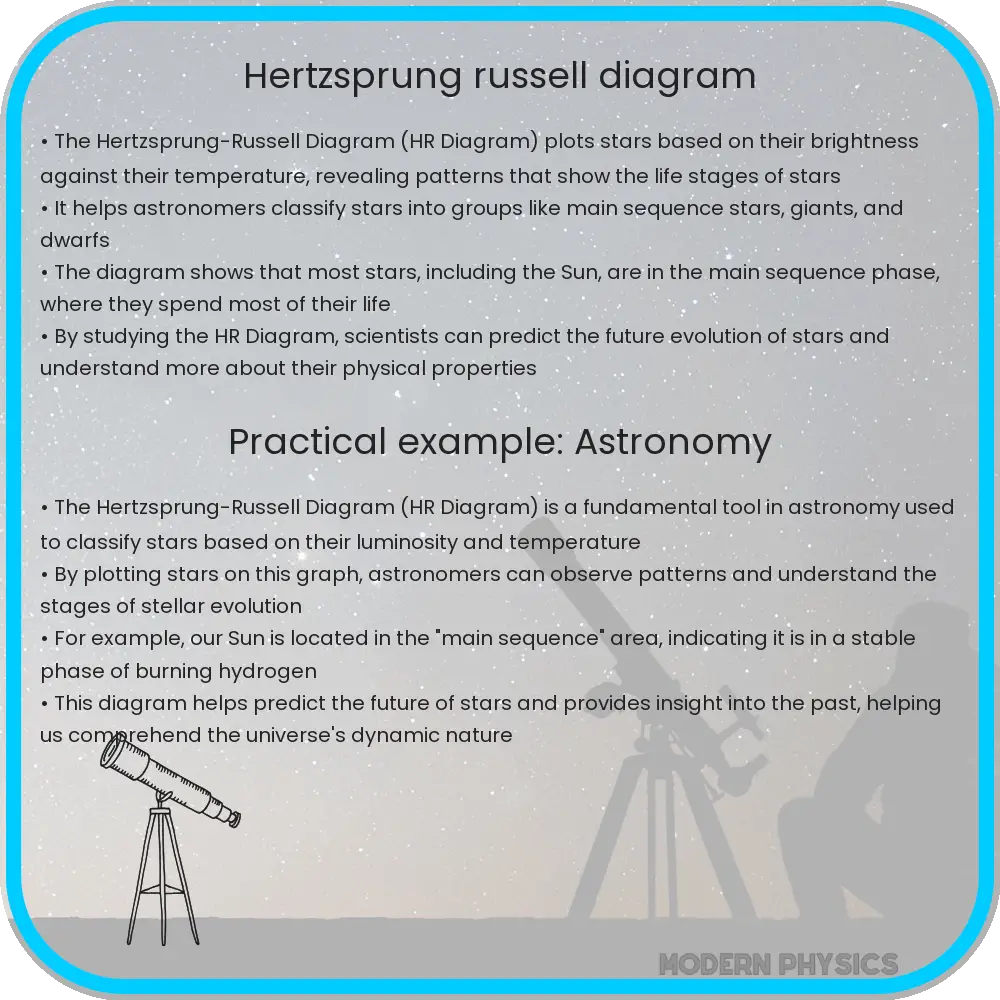Explore the Hertzsprung-Russell Diagram’s role in classifying stars by luminosity, temperature, and evolution, revealing insights into the lifecycle of stars in the cosmos.

Hertzsprung-Russell Diagram: A Comprehensive Guide
The Hertzsprung-Russell Diagram, or H-R Diagram, is a pivotal tool in the field of astronomy that provides a graphical representation of stars based on their luminosity, color, temperature, and evolutionary stage. Developed independently by Ejnar Hertzsprung and Henry Norris Russell in the early 20th century, this diagram has become fundamental in understanding the life cycle and classification of stars.
Stars Classification in the H-R Diagram
In the H-R Diagram, stars are plotted according to their absolute magnitude (or luminosity) and their spectral type (or temperature). The vertical axis represents the luminosity of the stars, usually expressed in terms of the Sun’s luminosity. On the other hand, the horizontal axis displays the temperature of the stars, which decreases from left to right, contrary to intuitive expectation. This arrangement places the hottest, bluest stars to the left and the coolest, reddest stars to the right.
- Main Sequence: The diagonal band stretching from the top left (hot, luminous stars) to the bottom right (cool, dim stars) represents the main sequence, where stars spend the majority of their lifetimes burning hydrogen into helium.
- Giant Branch: To the right of the main sequence, there are the red giants and supergiants, stars that have expanded and cooled after exhausting their hydrogen fuel.
- White Dwarfs: Located at the lower left, these are small, hot stars that represent the final evolutionary stage of stars not massive enough to become supernovae.
Understanding Stellar Evolution through the H-R Diagram
The H-R Diagram is not just a tool for classification; it also illustrates the evolutionary paths of stars. For example, our Sun is currently in the main sequence stage but will one day expand into a red giant before ending its life cycle as a white dwarf. By studying the positions of stars on the H-R Diagram, astronomers can deduce their ages, chemical compositions, and life expectancy, offering profound insights into the life cycles of stars.
Stellar Magnitude and Its Role in the H-R Diagram
The concept of stellar magnitude plays a critical role in the H-R Diagram, representing the apparent and absolute brightness of stars. Apparent magnitude refers to how bright a star appears from Earth, while absolute magnitude reveals a star’s true luminosity regardless of its distance from us. This distinction helps astronomers understand intrinsic stellar properties versus those affected by distance and interstellar matter.
Chemical Composition and the H-R Diagram
Another critical aspect illustrated by the H-R Diagram is the chemical composition of stars. Stars on the main sequence have different proportions of hydrogen and helium, affecting their temperature and luminosity. As stars age, heavier elements like carbon, nitrogen, and oxygen form through nuclear fusion, influencing their path on the H-R Diagram. This transformation is crucial for understanding the chemical evolution of our universe.
Conclusion
The Hertzsprung-Russell Diagram serves as a window into the vast and varied lives of stars. By mapping the characteristics of stars onto this diagram, astronomers can infer not only individual stellar properties but also broader patterns of stellar evolution. The H-R Diagram remains a fundamental tool in astrophysics, providing insights into the processes that govern the birth, life, and death of stars. Through its continued use, we deepen our understanding of the cosmos, illustrating the interconnectedness of time, matter, and energy in the celestial realm.
